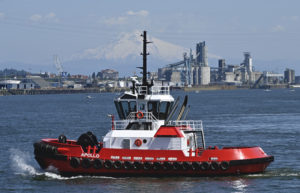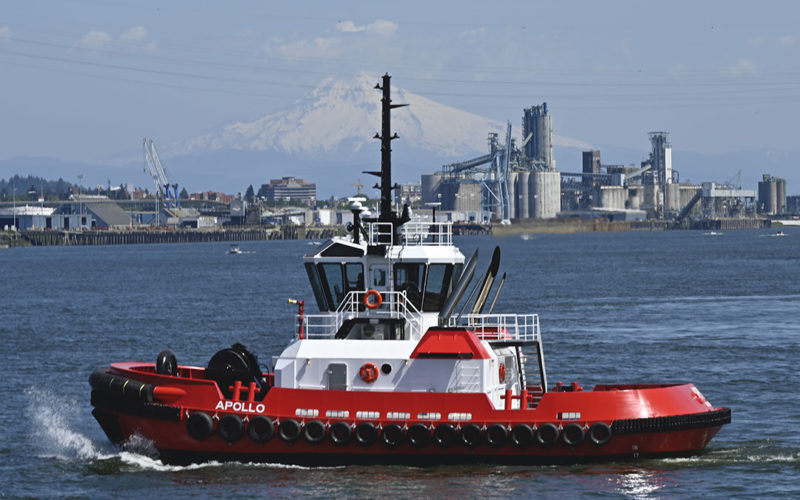
Crowley is adding new muscle to its California ship-assist fleet with a new ASD tugboat delivering more than 90 tons of bollard pull.
Diversified Marine in Portland, Ore., is on pace to deliver the 82-foot Apollo in June 2021. It will work in San Francisco Bay handling tankers and other large ships calling on the region.
Apollo is a sister tug to Hercules, delivered last spring by Diversified. Crowley has chartered both tugboats from owner Brusco Tug & Barge of Longview, Wash. Both tugs share the same Robert Allan Ltd. RApport 2500 platform. But, the 6,300-hp Apollo has more powerful Caterpillar engines and larger z-drives, giving it an estimated 95 short tons of bollard pull. Hercules, with 6,008 horsepower, pulled 89 short tons during sea trials last year.
“What we are trying to do with Hercules and Apollo is get an escort boat that could pull double duty as a really good assist tug and a good escort vessel,” said Paul Manzi, Crowley’s vice president of asset management. “These boats pack quite a bit of bollard pull for their hull design.”
Apollo is named for a Crowley vessel built in the 1960s that offered high horsepower in a relatively small package. The new tug replaces the 100-foot Valor-class Veteran in San Francisco Bay, which Crowley chartered soon after its construction in 2014. Hercules supplanted Veteran a year earlier in L.A./Long Beach. Crowley has not said what, if any, role Veteran will have in the fleet in the future.
“We are in a continual drive to renew our fleet and revitalize our fleet. Apollo and Hercules are part of that plan,” Manzi said. “As we go into the future, we are looking to continue that process.”
Apollo is shorter and nimbler than Veteran, which should improve performance and safety while working alongside a ship, Manzi said. The tug also burns substantially less fuel, and its EPA Tier 4 engines produce less harmful emissions. The new tugboats align with Crowley’s goal to become the most sustainable maritime and logistics company in North America by 2025.
“This ambition starts with continuing and enhancing our stewardship of the environment, protecting the world we serve and reducing our carbon footprint,” Crowley Chairman and CEO Tom Crowley said in a video released in late April.
He referenced Crowley’s two existing cargo ships that run on liquefied natural gas. Crowley also noted the company’s new all-electric tugboat design and the company’s investments in offshore wind energy.
The RApport 2500 design used in Apollo and Hercules is based on the RApport 2400 series of z-drive tugboats developed a generation ago by Robert Allan Ltd. of Vancouver, British Columbia. These early models were precursors to the advanced tugs the firm is now known for.
Design characteristics of the 2400 series include a flush deck and a small house. The tugs gained a reputation as responsive, nimble and cost-effective to build and operate. According to Robert Allan naval architects, the 2400-series tugs have a “slippery” hull form that is “ideal for fast maneuvering, fast side-slip and rapid response.”
The 2500 series, a nod to the 25-meter length, builds on the strengths of its predecessor. The tugs are 3 feet longer and 10 feet wider, giving them enhanced stability to accommodate larger engines and deliver more bollard pull. The small skeg under the keel is sufficient for escorting ships in the harbor without affecting maneuverability when docking ships.
Apollo underwent some notable design changes to ratchet up the bollard pull. Most significant was the use of 16,000 pounds of scrap steel ballast within the skeg to improve its stability during escorts.
“We did some work within our in-house computational fluid dynamics program to do the escort predictions, and that is where we found if we put some ballast in the skeg we could improve the escort capability,” said Henry Reeve, project director and senior naval architect at Robert Allan Ltd.
Hercules did not require the extra weight to achieve its escort stability criteria. The larger z-drives and Crowley’s desire for an escort notation led to its inclusion on Apollo, which Reeve acknowledged is uncommon.
“It is a little bit of diminishing return. The boat gets more stable but sinks down, and then deck edge immersion can seep in,” he said. “It is all about striking the right balance.”
Propulsion on Apollo consists of two Caterpillar 3516E engines, each generating 3,150 hp, paired with Berg Propulsion MTA 628 FP z-drives through Centa carbon-fiber shafts. The Berg drives have 2.8-meter nozzles (9.2 feet), compared to the 2.7-meter drives (8.86 feet) on Hercules.
Electrical power comes from two 118-kW Cat C7.1 gensets installed along the centerline between the two Cat mains. The gensets power the 75-hp Markey DEPC-52 electric hawser winch on the deck, and the 150-hp electric Baldor motor driving a 1,250-gpm Carver fire pump. The pump supplies water to a single forward-facing Elkhart Brass monitor.
The winch, identical to the unit on Hercules, features Markey’s Render/Recover system to maintain steady line tension in dynamic conditions. “Safety features include e-stop and escape functions, both in the wheelhouse and on deck,” said Scott Kreis, Markey’s vice president of sales and engineering.
“Energy efficiency is maximized through the use of a variable-frequency controller, using only as much power from the generators as needed to support winch performance at any given moment,” he continued.
RApport 2400-series tugboats were typically outfitted as day boats, with limited crew accommodations. The 2500-series Apollo is a bit more generous, owing in large part to space created by the wider beam. The main deck has a galley and mess, laundry machines and a head. Deck lockers on both sides of the house, one of which stores the FM-200 fire suppression system for the engine room, reduce the internal space.
Below deck, there are three cabins forward of the engine space, each with two bunks. The head has a single shower rather than the two in Hercules, creating more storage space for the crew, according to Kurt Redd, Diversified’s president.
Redd has plenty of experience building RApport-series tugboats for Brusco Tug & Barge. Between 2001 and 2017, the yard delivered seven 2400-series tugs to Brusco, which kept some for its own use and chartered some to other operators.
Hercules and Apollo bring the number of tugs Diversified has built for Brusco to nine. A third new vessel in the 2500 series, and the 10th overall in the ongoing partnership, is under construction. It will have more powerful engines and will deliver about 100 tons of bollard pull.
“Our relationship with the Brusco organization has been phenomenal over all these years, and we look to keep building,” Redd said.
Hercules arrived in L.A./Long Beach last spring and has handled all comers at the busy, high-traffic ports. It earned strong praise from the local pilots.
“The guys love it,” said Capt. John Strong, vice president of Jacobsen Pilot Service in Long Beach. “It has everything we want, including lots of power. It’s short, which is a great advantage, and it has quick-reacting units on it.”
Crowley expects similar performance from Apollo when it enters service later this year.

